LESSON 12: Cards That Pass in the Night
This is a very important lesson for in it I give you three of the greatest card classics known to Magic.
Be sure to review Lesson 9 before beginning the study of this lesson. In that lesson I set forth for you some marvellous principles on which Card Magic is based. I hope that you mastered these principles as you will need a thorough knowledge of them to perform these effects.
In addition, I give you the following new card principles:
1 -- The Card Transfer
2 -- The False Count
3 -- Misdirection Palming
4 -- Pocket Concealment
5 -- Self-Contained Card Vanish
6 -- Back to Front Hand Card Vanish
7 -- Pivot Card Vanish
The mechanical arrangements are: 1 -- The Sleeve Pocket
2 -- Shoulder Concealment
1. CARDS THAT PASS IN THE NIGHT
This is my version of the famous "Thirty Card Trick" or "The Cards from Pocket to Pocket," which has been so popular with conjurers. Every magician of note has his own angles of working this effect and various sleights which he uses in accomplishing it. I have used many ways in presenting this experiment, but the one that I am going to teach you is my favorite method.
This effect is one of those magical experiments which seem to be performed supernaturally. It permits of fine Showmanship and enables you to impress upon your audience the fact that you are doing Master Magic.
EFFECT:
Twelve cards are counted into the performer's left hand by a spectator and twelve cards are counted into his right hand also. Spectator then wraps the right-hand packet of cards in a handkerchief and holds it during performance of effect. The left-hand packet is given to another spectator to hold. Someone in audience is requested to call a number between one and five. Let us assume that number three is called. Performer now says he will cause three cards to pass from the spectator holding the twelve cards to the spectator holding the packet wrapped in the handkerchief. One card passes. Another card passes. Performer counts packet of cards and finds there are only ten. Magician now pretends to take a third card from packet and to hold its "spirit" in his hand. Spectator then counts the cards and finds there are only nine. Magician now pretends to put the "spirit" card back and then the packet is found to contain ten cards again. The invisible card is removed again and the packet contains nine cards. Performer tosses invisible card to packet in handkerchief. Three cards have now passed. Spectator takes packet from handkerchief and counts cards. He finds that he now holds fifteen cards instead of twelve.
PARAPHERNALIA:
1--A deck of cards.
2--A borrowed handkerchief.
SECRET AND PATTER:
To Perform:
Take deck of cards from pocket or borrow a deck and remove cards from case.
Have two gentlemen come up from audience. You stand between the two men. Turn to the one on the left and say,
"Will you, sir, kindly help me with this experiment? I want you to shuffle this deck thoroughly and count twelve cards into my left hand."
NOTE:
As a rule, performers count fifteen cards into each hand or onto the table. The two pockets contain thirty cards. This is where the trick gets the name "Thirty Card Trick." However, I prefer to use twelve cards in each packet for several reasons. You will understand this when you master the effect.
Give cards to spectator to shuffle.
"Count TWELVE cards into my left hand one at a time and count them loud enough so that all may hear you."
Performer holds out left hand, palm upward, and spectator counts twelve cards out one at a time into his palm. Fig. 1. The cards should be counted backs up. If spectator does not count loud enough, you count with him. You must impress upon your audience the fact that twelve cards are in your hand.
"TWELVE cards."
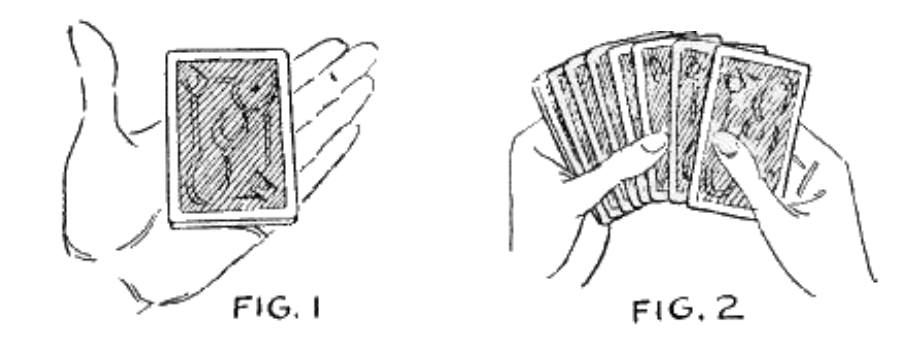
Hold up packet of twelve cards and fan it out slightly. Fig. 2.
"You are correct, sir — a very good mathematician."
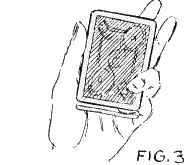
Square up cards again. As you do so, insert first joint of little finger of left hand under top three cards in packet. Your left hand and little finger are in the same position as they were in doing the simplified pass explained in Lesson 9. Fig. 3.
Drop left hand with packet at your side. Hold cards so that audience is not aware of position of little finger, separating top three cards.
To the audience it appears that all you have done is to fan open cards to be sure that spectator was right in his count.
"Now, count TWELVE cards onto the palm of my right hand. Count them one at a time aloud so that there will be no mistake in the number."
Spectator counts twelve cards out onto performer's right hand as he did onto the left hand.
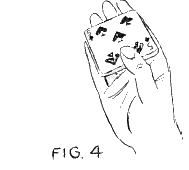
Now square up cards and reverse them so that they face upwards. Hold them between tips of fingers and thumb. Fig. 4.
Hold hands far apart — packet in right hand with faces of cards up; packet in left hand with little finger separating top three cards. Fig. 5.
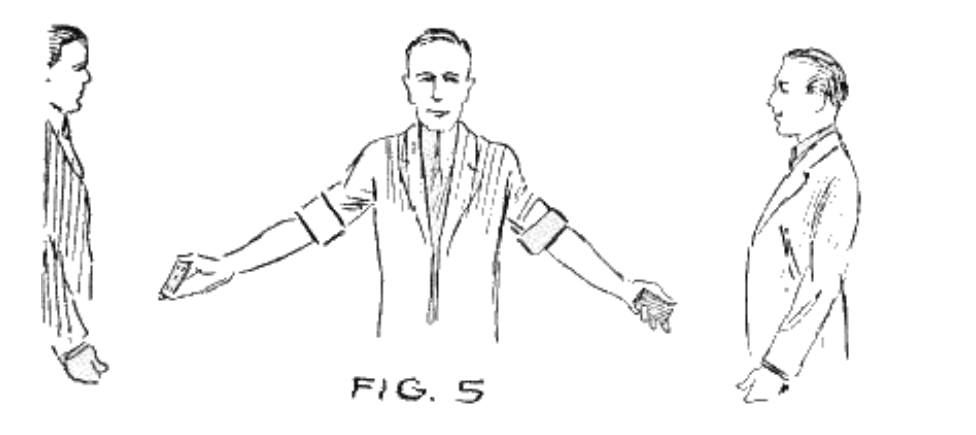
"Twelve cards in my right hand also. Thank you."
Turn slightly to left toward spectator there. As you do so, take position shown in Figure 6.
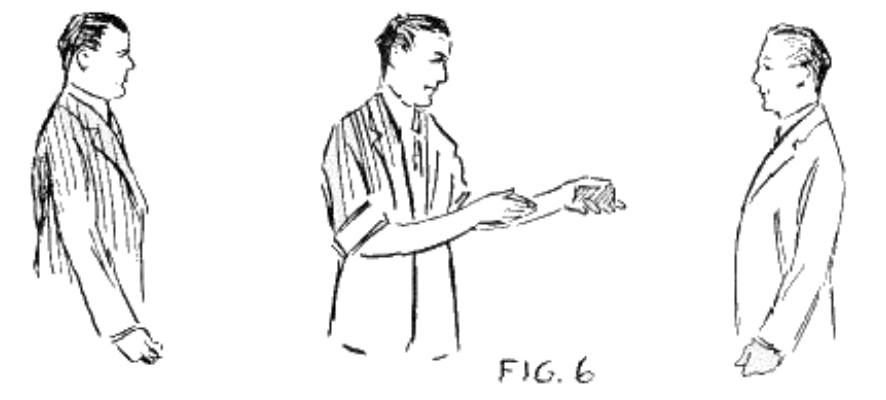
Turn your right hand back to audience and bring packet of cards in each hand on a horizontal line with each other.
Say to gentleman on left:
"Have you a handkerchief which we can use?"
2. THE CARD TRANSFER:
The following move teaches you the principle of transferring cards from one packet to another. Study it carefully and practice it until you can perform it perfectly.
Your hands are in this position. Fig. 7. A designates the top three cards on the left hand packet.

As you ask for handkerchief, quickly pass packet in right hand over packet in left hand. Fig. 8.
Place your right thumb against the A section (top three cards) of packet in left hand. Your little finger separates these three cards from rest of packet so that it will not be difficult to grasp them with thumb of right hand. The first joints of second and third fingers of right hand bear down on the front end of the three cards. Fig. 9.
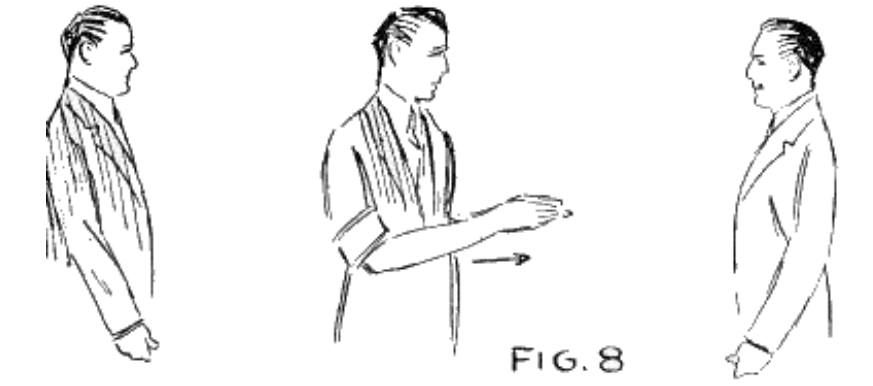
Carry these three cards away at bottom of packet in right hand. Bring them up against the rest of packet. Fig. 10.

This whole move is done very quickly. It must appear that you merely passed the right hand past the left as a gesture in asking for the handkerchief. You must not hesitate an instant in bringing away the three cards from left packet. Finish leaves right hand up in front of spectator for a moment. Fig. 11, next page.
You now have NINE CARDS in LEFT PACKET and FIFTEEN CARDS in RIGHT PACKET.
"Thank you, that one will do nicely. I will have you wrap the TWELVE cards I hold here in the handkerchief. Wrap them securely so that no cards can get in or out without your knowing it."
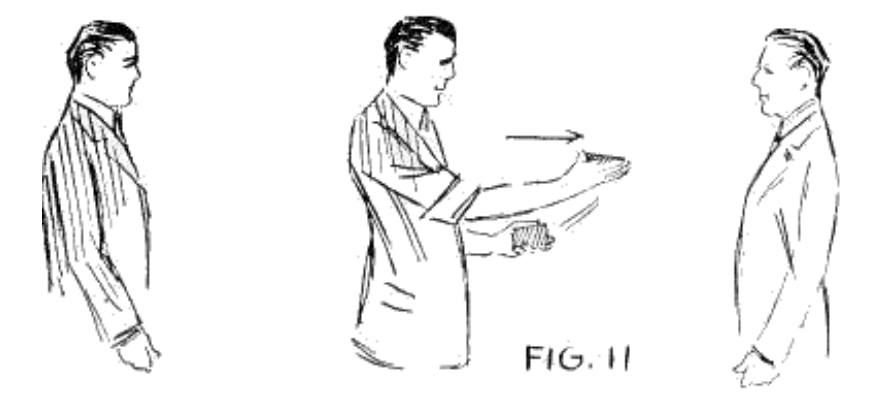
Spectator wraps packet of fifteen cards in handkerchief. Fig. 12.
Of course, audience and spectator think that packet contains twelve cards.
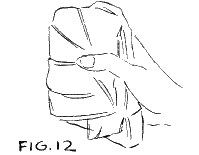
"Hold them in your right hand, up about shoulder height, so that the audience can see them. Now, to make sure that the gentleman placed TWELVE cards in my left hand, I will count them again." Your next move is to prove that the NINE cards which you hold are TWELVE.
3. THE FALSE COUNT:
Hold the nine cards faces toward you in your left hand, thumb on top of cards. Fig. 13.
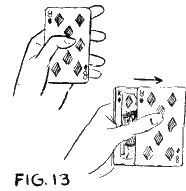
Push first card over to right with thumb, grasp it with right hand and remove from packet. As you do this, count aloud. Fig. 14. "One."
Now push second card over to right a little with thumb. Bring card in right hand up behind packet in left hand and place right thumb on top of second card. Fig. 15.

You apparently take this card, but in reality you perform the FALSE COUNT. Move your right thumb toward right to make the sound of drawing the card from the pack. The second card extends over the edge of the pack for about an inch. By bending card at the edge with right thumb and then releasing it you get the snapping sound of removing a card from the pack. As your right thumb snaps the card, your left thumb draws the second card back onto the pack. Your right hand moves to the right several inches with the one card in it just as it would if you had really taken off another card from pack. Fig. 16.
"Two."
The audience has heard the drawing of the card and the snap, and naturally they think that you have pulled TWO cards from the packet and now have them in your right hand. You count -"two"- to help the illusion.
Stand in front of your mirror and practice this method of False Counting. The best thing to do is to actually count the cards and pass them from left hand to right. Then imitate the natural moves and hold back a card now and then.
False Counting is a very important principle in Magic. It sometimes proves to be a regular life-saver in an emergency.
You must be able to perform the move so well that the keenest eye cannot tell whether you did a straight or a false count.
Count the third card actually into right hand on top of the one card there, making the snapping sound as you bring the card away from the packet.
"Three."
False count the next card, making the snapping sound.
"Four."
Count next card fairly, bringing it away from packet on top of two others in right hand.
"Five."
False count next card.
"Six."
You have in reality now three cards in right hand and six in left packet. Audience, however, believes that you have counted six cards into your right hand and have six left in packet. The six cards left may now be counted fairly.
"Seven - eight - nine - ten - eleven - twelve."
TIME and RHYTHM are the important elements in False Counting. Count the cards fairly fast. Be sure to keep the time and rhythm in straight counting and false counting the same.
If you have difficulty in pulling card back onto left packet with left thumb, do not worry about it. The
time and rhythm of your count is more important than this. The ability to do this will come to you with practice.
Practice the False Count until you have it down fairly well and then try it out on someone without letting him know what you are trying to do.
To gentleman on right, say,
"And I shall ask you to hold these cards. Take them with your right hand and hold them up on your right lapel."
Give packet to spectator and then place his right hand with the cards on his right lapel at the button-hole. Fig. 17.
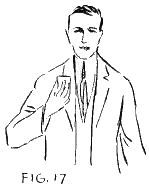
The reason for doing this is to place the cards out of the line of vision of the spectator. This keeps him from counting the cards too. Occasionally you find an assistant who works against you and is contrary. Placing the cards in this position will forestall any such difficulty.
"I was going to tell you to place them against your heart, but it is over on the left and I want to do the trick RIGHT."
Pick out some intelligent looking person in the audience and ask him to call out any number between one and five.
"Will you please give me any number between one and five?"
IN THE MAJORITY OF CASES THE PERSON WILL SAY THREE. It is a psychological fact that this number will be called in most cases when you ask for a number between one and five.
We will carry on the experiment now just as if the spectator had called Three. Later on I will tell you the method of procedure if the numbers one - two - four - or five are called instead of three.
"The lady (or gentleman) says 'THREE.' That was your own free choice, was it not? You could have selected one, two, four. or five. But she says 'Three.' Then three it shall be. Now, note how matters stand, for I am going to show you an __ experiment in miracle magic that you will remember as long as you live. The gentleman here counted twelve cards into my left hand and twelve cards into my right hand. They were recounted to prove the number to be correct. At no time have my hands been together while they held the cards. The gentleman took the twelve cards himself from my right hand and wrapped them securely in his handkerchief. The remaining twelve cards were recounted and placed on this other gentleman's lapel. I called for a number -- any number -- and the lady said, 'Three.' What I intend to do now is to cause THREE cards -- the number selected — to pass from the packet on the gentleman's lapel to the packet in the handkerchief which this gentleman on the left is holding. Not One, Two, Four, or Five cards -- but Three. I shall pass the cards invisibly. Night-time when all is dark is the best time to have the cards go invisibly. When the CARDS PASS IN THE NIGHT, then you cannot see them. As we are in the light, however, we will have to pretend we are in the dark, and if your imagination is good you can imagine inky blackness between the two gentlemen. Just right for the spirits to work in. Now, I shall take a card from the gentleman here."
Pretend to take a card from gentleman at right. Hold up right hand as though you had a card in it.
"I have a card here in my hand, but as we are in the dark you cannot see it. I shall toss it to my friend here."
Make tossing motion to gentleman on left. "You could not see it, but did you feel it?"
Gentleman usually laughs and says, "No."
"Perhaps you are not feeling so well."
If he says, "Yes," say, "Ah, the gentleman is feeling pretty good this evening."
Pretend to take another card from packet at right. Hold up right hand as though you held card.
"Now I have another card, but the darkness, of course, again prevents you from seeing it. Again I toss it to the gentleman."
Make tossing motion to gentleman at left.
"Of course, you felt that one."
Perhaps gentleman nods a little this time.
"See — he is feeling better already. Suppose we actually see whether the cards are passing over to the gentleman. I'll blow away the darkness."
Blow into the air as if you were blowing out a candle. "Well — well — it's light again." To gentleman at right.
"Will you please give me the cards?" Take the cards and hold them in left hand.
"I will show you that I have really taken two cards from this packet. Two from twelve is ten, is it not?"
FALSE COUNT the nine cards in the packet. Do your false count on the second card to make the nine cards count ten.
Count each card loud and distinctly to convince audience that you hold ten cards in your hands.
"The two have gone. But you said you wanted three to go. Well, all I have to do is to make it dark again. There you are. A total eclipse. I will now take another card from the pack."
Pretend to take another card with right hand and hold up hand as though you held card in it.
To gentleman at right.
"Will you please count the cards yourself to see whether I am holding a card or not?" Give the gentleman the nine cards.
"Count them into my left hand one at a time." Spectator counts cards.
"One, two, three, four, five, six, seven, eight, nine. So you see I am really holding the tenth card. Now I place it back in the pack and I'll count the cards again." FALSE COUNT the cards as ten.
"One and nine makes ten. Now take the card out again." Pretend to take card out again and hold it in right hand. "Count the cards again and we have nine." Cards are counted again.
This repetition cannot help but convince the audience that there are ten cards (though you really have only nine) and that in some mysterious manner you get a card out and into the packet.
This point of repeating and emphasizing a certain fact or supposed fact is a great thing in Magic.
"So all I have to do is merely to toss the card through the darkness into the handkerchief. If the gentleman will count the cards himself he will find that instead of holding twelve cards he now holds fifteen. The extra
three cards are those which passed over from this other packet. Now blow away the darkness." Blow again.
"And it is light again. Count the cards slowly into my left hand." Hold the packet of nine cards in right hand.
Spectator counts the fifteen cards into your left hand and you count with him, especially accenting THIRTEEN, FOURTEEN, FIFTEEN.
Bring the packet of nine cards from right hand over on top of those in left hand but keep them separated by little finger of left hand.
Thank the gentlemen for helping you. Just as the one on left starts to turn and go, PLACE RIGHT HAND OVER CARDS AND PALM THE NINE CARDS. Then grasp his right lapel with your left hand and open his coat.
"Pardon me, sir, before you go --"
Reach up under his coat to a point under and a little behind his right shoulder. Fan cards out from right palm and bring them out so that audience can see them.
"Before you go I'll take those few cards of mine which you have up under your coat."
This last move is a good COMEDY touch. This you will find it to be a good finish after you are able to palm the cards successfully.
Back of right hand is toward audience and they do not suspect that you have cards in hand. You put your hand under the spectator's coat quickly and when you suddenly fan the cards and produce them, it causes a stir of surprise and amusement to run through your audience.
WHAT TO DO IF THE NUMBERS ONE, TWO, FOUR, OR FIVE ARE SELECTED INSTEAD OF THREE
The test of a real magician is his ability to meet emergencies — the ability to carry on his effect even when unexpected things arise during his performance.
According to a law of psychology when a person is asked to call a number between one and five, he will call three in most cases. In performing this effect you transfer three cards from one packet to the other, thus making fifteen cards in one packet and nine in the other. You are counting on the working of this psychological law to make the spectator call the number three.
You must, however, be prepared for emergencies -- for the times when spectators will call numbers other than three.
If the spectator calls number one, you say,
"I want any number between one and five."
If number five is chosen, the above also applies.
The spectator then thinks that you want number two, three, or four and will choose another number.
If number two is called, you must change your patter to suit this number instead of three. You played up and emphasized the fact when number three was chosen, but with number two do not do this.
Do not for a moment let your audience know that number two is not the number you wanted. They must think that any number chosen is all right.
Perform your experiment to the point where two cards have passed. Prove this by FALSE COUNTING the nine cards to be ten. Then continue in this way:
"I have caused the two cards which were chosen to pass. Now would you like to have me explain to you how the cards pass over? All right, this is the way it is done."
From this point you may complete your experiment with the third card, supposedly explaining the effect by passing a third card. Use the patter about causing the card to pass in the darkness. Pretend to take the card from the pack, replace it, and take it out again just as you do when number three is selected by spectator.
If number four is chosen, start your experiment this way:
"How would you like to see the cards pass--VISIBLY or invisibly?"
Most people would like to see them go visibly. They want to see how it's done and perhaps expect the cards to fly through the air.
"VISIBLY? Then visibly you shall see them go. (To gentleman on right) Will you please give me one card?"
Gentleman gives you one card.
"You are certain that there is just one card? Fine. Now I will carry it VISIBLY over to the gentleman at
my left and have him place it with the other cards in the handkerchief. Take the card, sir?" Gentleman places it in handkerchief with other cards.
"One card has passed. How many did you say you wanted to pass, sir? Four? All right, we will pass another one VISIBLY."
At this point a snicker runs through the audience for they think you are just being funny.
"What's that? It is no trick to do it visibly? Well, maybe it isn't, but you said you wanted the cards to go visibly, so visibly they are going. You can all see them, can you not? What's that? You would rather see them travel INVISIBLY? Then we'll have them go invisibly."
One card has been passed to the packet in the handkerchief so that you now have eight in the packet held by spectator at right. You may now complete the experiment, pretending to pass three more cards. You must change your patter, of course, to conform to the needs of this occasion.
NOTE:
Another version of this experiment which I use is this: Instead of the darkness idea I use the spirit card idea. I say that I am causing the spirit of the card to travel from one pack to the other. I tell the audience that I do this by dematerializing the card and then materializing it again.
When I hold the invisible card up I use this patter:
"Perhaps some of you cannot see the card. The reason for this is that I am holding the spirit of the card which I have dematerialized. The card in its spirit form vibrates at the rate of four million times a second so that you cannot see it."
You see what opportunity you have for using your imagination in Magic. Give it full play and you will be delighted at the results you get in patter and in putting effects across.
3. THE CARDS UP THE SLEEVE
This is another old card classic. There are many methods and routines used in performing this effect. Each performer uses a variation of the experiment which best suits his individuality. After you have mastered the trick as I teach it to you, you may start blending in other principles or varying parts of the effect to develop a routine which you like best.
In this effect STUDY YOUR MISDIRECTION CAREFULLY and MASTER YOUR PALMING.
This effect is a good one to use after CARDS THAT PASS IN THE NIGHT. It is impromptu and can be performed on any occasion.
EFFECT:
Performer counts twelve cards from the deck, holding them toward the audience so that they can be seen. Cards are held in left hand. Magician pulls out right trousers' pocket to show that it is empty. Performer says that cards will pass invisibly up his sleeve into his empty pocket. He clicks the packet in his left hand and then removes a card from his right pocket. This is repeated until the twelve cards have passed one by one, apparently through the performer's sleeve, into his pocket.
PARAPHERNALIA:
1--A deck of playing cards.
SECRET AND PATTER:
To Perform:
If you use this effect after THE CARDS THAT PASS IN THE NIGHT, you may start with this patter:
"Perhaps you would like to know just how I cause the cards to travel in the darkness. I will explain it to you in the light. First, you must have twelve cards."
Count off twelve cards from deck, calling the number of each one distinctly so that audience will be sure that twelve have been counted. Hold faces of cards to audience so that spectators see them and can perhaps remember a few.
Place rest of deck on table. Transfer the twelve cards from right to left hand.
"We have twelve cards."
Fan the cards with faces toward audience, using both hands in doing it. Close fan and insert little finger of left hand to separate top three cards. See Figures 2 and 3 of this lesson for method of doing this:
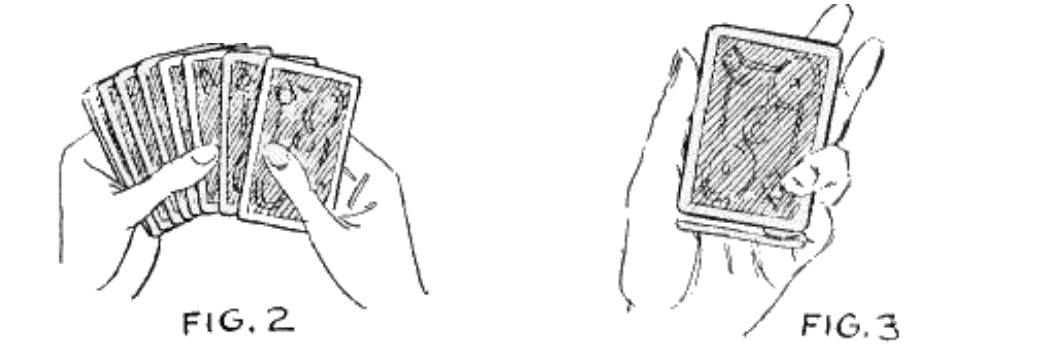
Stand with right side turned a little toward audience. Extend left hand out, holding backs of cards toward audience.
If you are performing on a stage you may call up a spectator to assist you. If you are performing in a parlor you may have a spectator remain seated while reaching into your pocket.
"Will you, sir, please reach into my right trousers' pocket to see that my pocket is empty and that all is fair?"
Spectator reaches into pocket and convinces himself and the audience that pocket is empty.
While spectator is reaching into pocket, turn your right side toward audience. Figure 18.

MISDIRECTION PALMING:
Place right hand over cards. With aid of little finger of left hand, palm the top three cards of the packet in right palm. Figure 19.
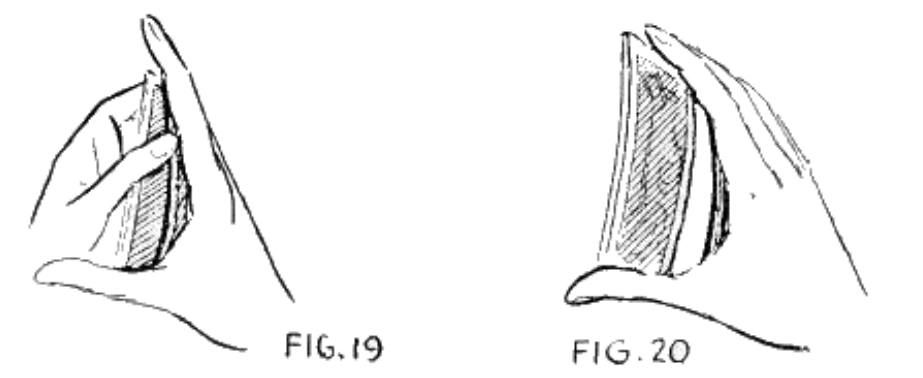
Hold the other nine cards in right hand also to make it appear that you merely transferred packet from left to right hand. Figure 20.
"You are convinced, are you not, that there is nothing in my pocket?"
Figure 21 shows position of cards in hand. Three cards are palmed in right hand and remaining nine cards of the packet are held by thumb and forefinger.
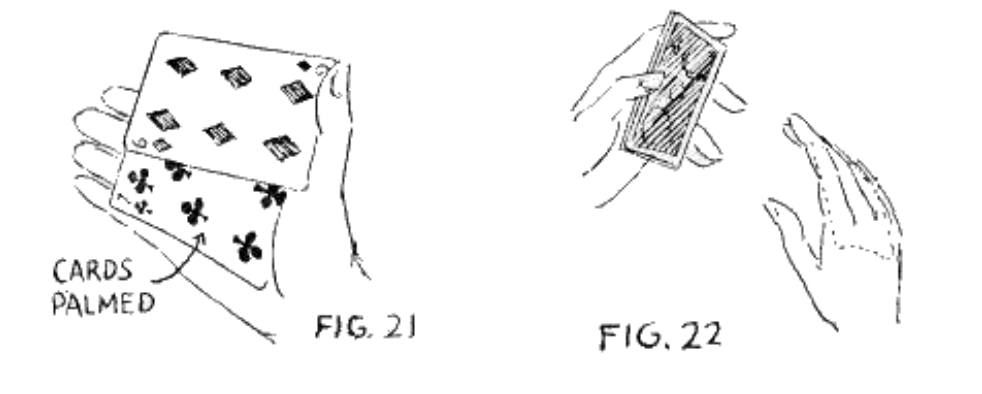
The audience sees only the back of your hand.
Place the packet of nine cards into left hand again and draw right hand with palmed cards away toward trousers' pocket. Figure 22.
Bạn đang đọc truyện trên: Truyen4U.Com